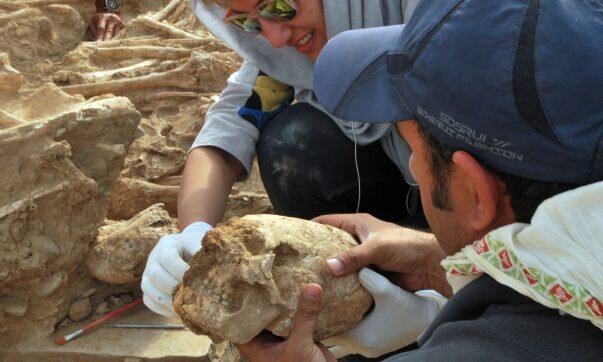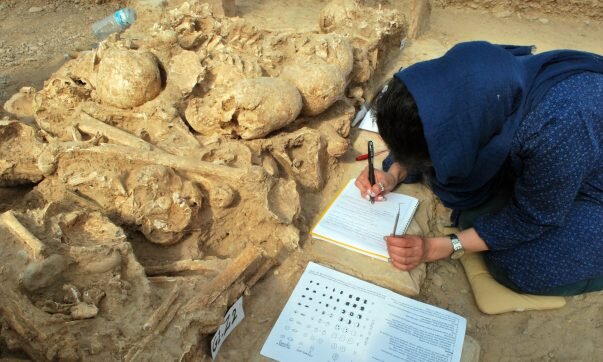Archaeologists have discovered 134 traditional skulls Deformed skulls in the largest cemetery of the rural era in the Chegasofla Cemetery in Khuzestan. 400 skeletons dating about 6000 years old have been found in this grave
TEHRAN – Some archaeologists believe that “modified human skulls” are one of the unique finds among ancient cultural materials.

Such deformations may have been caused by various factors, including diseases, cultural factors, soil pressure after burial, and even life events. However, skulls that have been “Intentionally” deformed are of particular importance.
On the Iranian plateau, samples of these skulls have been obtained from archaeological excavations. Moreover, evidence of intentionally deformed skulls in southwest Asia has been reported though in small numbers.
In southwest Iran, specimens of such skulls have been found in the Tol-e Chega Sofla in the Zohreh plain (Behbahan of Khuzestan province). Since 13 deformed skulls have been excavated at this site so far and these skulls are well preserved, there is an excellent opportunity to study this issue.
According to an article authored by Iranian archaeologists Mahdi Alirezazadeh, Hamed Vahdatinasab, and Abbas Moghaddam, a study of the deformed skulls of Tol-e Chega Sofla reveals similarities in the methods of skull deformation with other regions of Southwest Asia. In this area, a bandage has been used to deform the skulls. However, there are also different traditions of deformation in Tol-e Chega Sofla.
In the early 20th century, the discovery of elaborately decorated pottery vessels from Susa attracted much attention and created ample amazement among scholars of archaeology and art history. Although excavations of the Susa cemetery appear to be imperfect and dubious when assessed against our current stratigraphic and documentation standards, they have initiated many further actions; including numerous, and long-term, investigations to understand pre- historic developments in the Susiana plain and its neighboring areas.

From establishing chronological orders to attempting to better understand the process that led to the emergence of complex societies and early states, scholars have spent many decades examining archaeological finds in Susiana and the adjacent plains. For some reason, however, Susiana’s adjoining southeastern plains of Zohreh and Behbahan, particularly in Tol-e Chega Sofla, have attracted less attention.
According to the article “Tol-e Chega Sofla Cemetery: A Phenomenon in the Context of Late 5th Millennium Southwest Iran”, which is co-authored by Iranian archaeologists, Negin Miri and Abbas Moghaddam,
As the article suggests, evidence from the Tol-e Chega Sofla sheds fresh light on our current knowledge about the prehistoric societies of Greater Susiana.
Its considerable extent, the diverse grave structures, the richness and diversity of recovered grave goods, as well as numerous buried individuals are unprecedented phenomena compared to previously excavated contemporary sites.
“The findings from Tol-e Chega Sofla not only remind us to not underestimate prehistoric communities but demonstrate the need to review many of our previous assumptions.”
Tol-e Chega Sofla is located in the Zohreh plain, some 45 km south of the town of Behbahan, on the most eastern fringes of Khuzestan province. The site was identified for the first time by Hans Nissen and his colleagues from the Oriental Institute of the University of Chicago and the Freie Universitat Berlin in 1970.
The dead
Considering the size of the Tol-e Chega Sofla residential quarter (ca. 20 ha), the number of dead individuals as indicated by the excavated graves is relatively high (at least 102 individuals). The high number of individuals in the multiple burial graves has a primary explanation, and that is the constant use of graves for several generations. Some other explanations may also be considered: war or conflict, famine and starvation, pandemics or the prominence of ritual activities for the Tol-e Chega Sofla communities living in the Zohreh plain in the late 5th millennium, and who brought their dead to this cemetery.

Based on physical anthropology studies, the buried individuals in the ten excavated graves ranged in age at death between less than six years old to more than 40 years old. Most of them (21.3%) were aged between 30 to 35 years old and only a few were aged more than 40 years old (1.1%). Males and females were not separated and all age and sex groups were buried together with no applied segregation.
Deformed skulls
While earlier scholars believed that some post-burial factors, such as the pressure of the surrounding soil in the graves, created deformed skulls, it is now widely accepted that such deformed skulls were intentionally shaped during an individual’s life to represent some sort of cultural or social meaning. Although post-burial factors could also deform skulls, such unintended and natural causes typically lead to irregular deformations.
Deformed skulls are not unknown from archaeological contexts of the Near East and were common in a large area extending from southern Mesopotamia to southern Turkey. The oldest examples of intentional cranial deformation were reported from Early Neolithic sites in Southwest Iran.
At Tol-e Chega Sofla, the concentration of deformed skulls in grave BG1 (12 skulls) is striking. One example was also recovered from BG6, although the actual number might have been higher. The Tol-e Chega Sofla deformed skulls were shaped by one/two-band type circumferential head shaping from a very young age.
Some skulls were still in the process of being shaped at the time of death, while for some, the process had been completed. Seven female skulls aged between nine to 30 years old, and five male skulls aged between 17 to 25 years old were deformed.
Other findings
A wide range of findings, including pottery and stone vessels, metal objects and vessels, as well as small ornaments, were recovered from the excavated graves. The most interesting feature regarding the grave goods was a certain harmony between the diversity of grave goods in terms of type and material and the grave structures.
Pottery vessels are all well-fired, fine buff ware decorated with brown paint and include bowls, jars, and beakers. The most widely recognized enriching theme is the ventured plan, while other mathematical themes like insignias, as well as creature themes like columns of reptiles or bowing snakes, are additionally successive.
Tol-e Chega Sofla on World Heritage Tentative
Included on the tentative list of UNESCO’s World Heritage sites, Tol-e Chega Sofla embraces a settlement and a cemetery section. In the settlement section, five low and high mounds have been identified, with the elevation of the highest remaining ridge reaching more than 30m from the surrounding land. The cemetery section begins right on the southern slope of the site and continues near the heights of the Rag Sefid in the south. The settlement area is about 20 hectares and the cemetery area is ca. 2,000 by 800 meters.

During the 1970s, during an archeological overview by Hans Nissen from the Oriental Institute of the University of Chicago and the Frei University of Berlin, the site was distinguished and set apart as BZ.71 as the largest ancient site in the Zohreh Plain.
Tol-e Chega Sofla addresses a phase in the ancient times of Iran that is known in the archeological writing from the late Middle Susiana to the Late Susiana. Until this point, outright information from the Tol-e Chega Sofla has gone from 4,700 to 3,700 BC.
AM
Related Post
A shocking documentary proves that mermaids do exist
SHOCKING Revelation: Thuya, Mother of Queen Tiye, Was the Grandmother of Akhenaten and Tutankhamun—What Ancient Egyptian Secrets Did She Leave Behind?
Breaking News: Astonishing Discoveries at Karahan Tepe Confirm an Extraterrestrial Civilization is Hiding on Earth, and NO ONE Knows!
Breaking News: Researchers FINALLY Discover U.S. Navy Flight 19 After 75 Years Lost in the Bermuda Triangle!
NASA’s Secret Investigation: Uncovering the Astonishing Mystery of the UFO Crash on the Mountain!
Explosive UFO Docs LEAKED: Startling Proof That Aliens Ruled Ancient Egypt!